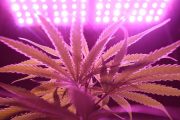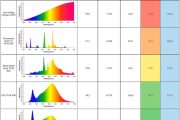Introduction
The standard lamp used for the preservation and transmission of the light radiation value is an important standard device in the light radiation measurement. The standard lamp with good performance is the basis for ensuring the uniformity of the light radiation value.
For a long time, due to the lack of a standard light source with sufficient blue end spectral power in the visible band, the measurement uncertainty of the 380-450 nm band is significantly higher than that of other bands. Therefore, it cannot meet the high-precision measurement requirements of electric light sources, biology, materials, aeronautics, and scientific research.
The spectrum of the LED light source can be modulated, and the spectral power of the blue end can be enhanced by certain methods. This provides a new technical approach for the development of new standard lamps. However, the spectrum of ordinary white LEDs sold on the market cannot completely cover 380-780 nm, and the energy is very low outside the 420-720 nm band, which is only suitable for the transmission of light measurement values.
Therefore, in order to increase the energy of white LEDs beyond the 420-720 nm band, this study uses 6 LEDs with different peaks and is equipped with special phosphors to extend the spectrum of white LEDs to the entire visible light range. In particular, the spectral power of the blue end is improved.
This wide-band white LED replaces the incandescent lamp for the transmission of the total spectral radiant flux, radiant illuminance, and radiance. Or as a reference light source for the calibration of the relative spectral sensitivity of the detector, the blue end can effectively reduce the uncertainty of the measurement results.
1. Current Status of Standard Lights
background
Optical radiation measurement standards have been developed along with the development of artificial lighting sources. In 1860, the earliest optical radiation measurement standard “candle” in human history was born. The special candle is ignited under certain conditions, and the horizontal luminous intensity of the flame is specified as 1 cd. Later, “Casor lamps” and “Hefner lamps” using liquid dyes appeared. In 1909, the United States, Britain, and France agreed to use a set of 45 carbon filament incandescent lamps to save the unit of luminous intensity. Since then, incandescent lamps have become the standard for measuring optical radiation. Because of its good reproducibility and long-term stability, it has been used until now. The production process of incandescent standard lamps is complicated and expensive, and it is becoming more and more difficult to obtain scientific-level standard lamps from commercial channels.
Development of new technology
The development of new standard lamps suitable for the transmission of optical radiation measurement values is a hot spot in the international optical radiation measurement. Many national metrology institutes have invested huge manpower and material resources to carry out research in this field.
The International Organization for Metrology and Standardization is working to establish an LED-based light measurement value transmission system and the development of standard devices that use LEDs as luminous bodies. “New calibration sources and illuminants for photometry, colorimetry, and radiometry have been included in the ten strategic plans by the International Commission on Illumination (CIE).
The Photometric Radiometric Advisory Committee (CCPR) established a special working group to explore the feasibility of using white light LEDs as the delivery standard for photometric measurements. South Korea has developed a LED chip-based total luminous flux measurement standard lamp with high color temperature and low color temperature, which can be customized according to customer requirements. The American Institute of Metrology and Philips has developed a wide-band LED standard light source for the transfer of the average luminous intensity, total luminous flux, radiant flux and spectral radiant flux of the LED. As shown in Figure 1
Fig.1 Spectrum of white LED with expended wavelength developed by NMIJ
2. Spectral Expansion Method
We adopt the method of digital simulation. For a group of LED chips with different wavelengths, the mixed spectral power distribution (SPD) Sm(λ,d) at a certain input control current d can be expressed as:
In the formula, λ represents the wavelength, and the value range here is 380-780 nm. d is the input control current, and n is the number of LED chips with different peak wavelengths used in the research. Si(λ,di) represents the SPD of the i-th LED chip when its input control current is di. Considering that the spectral characteristics of LED chips often change with its input control current, the SPD of each LED chip at any effective control current is obtained by pre-measured SPD interpolation during a series of control currents.
Therefore, the target SPD can be mixed by adjusting the input control current d of each LED chip. The target SPD here is CIE standard light source E (isoenergy light source). Then this adjustment process can be transformed into the minimum value problem of solving equation (2): (2)
(2)
In the formula, dopt represents the input control current of each LED chip to be sought. f1(d) represents the evaluation index of spectral matching accuracy (p).
This research finally adopted a set of 6 narrowband LEDs and special phosphors. The spectrum of the white LED extends to the entire visible light band, as shown in Figure 2. The developed wide-spectrum LED is a chip-on-board (COB) package, and each COB is composed of 48 LED chips in series and parallel. Set the voltage to 37 V and the current to 200 mA. When using 220V AC power supply, the current is 59.02 mA, the luminous flux is 250 lm, and the luminous power is 1 013 W.
Fig.2 Relative spectral power distribution of two wide spectrum LED lamps
3. Experimental Results
For the LED lights developed, we conducted a short-term stability assessment. During the test, the COB LED package was fixed on a semiconductor refrigeration fixture, and the temperature was set to 25 ℃. Randomly select a lamp to ignite, and perform measurement after preheating for 5 minutes. After shutting down, let it cool for 30 minutes, and then perform the measurement again. A total of 7 measurements were performed, and the measurement results are shown in Table 1. We also repeatedly measured the 4 sample lamps developed after an interval of 3 months to examine their long-term stability. The measurement results are shown in Table 2.
Table 1 Repeatability of wide spectrum LED
| Num | Current (mA) | Voltage (V) | Luminous Flux (lm) | CCt (K) |
| 1 | 20 | 32.724 | 48.505 | 4963 |
| 2 | 20 | 32.724 | 48.502 | 4962 |
| 3 | 20 | 32.724 | 48.505 | 4960 |
| 4 | 20 | 32.724 | 48.501 | 4962 |
| 5 | 20 | 32.724 | 48.501 | 4963 |
| 6 | 20 | 32.724 | 48.505 | 4963 |
| 7 | 20 | 32.724 | 48.502 | 4962 |
Table 2 Repeatability of wide spectrum LED at three months
| Num of the fixtures | Round 1 | Round 2 | Deviation between two rounds | |||
| Luminous Flux (lm) | CCt (K) | Luminous Flux (lm) | CCt (K) | Luminous Flux (lm) | CCt (K) | |
| 1 | 49.98 | 3866 | 49.98 | 3866 | 0 | 0 |
| 2 | 50.58 | 3991 | 50.58 | 3889 | 0 | 2 |
| 3 | 48.38 | 4964 | 48.50 | 4964 | -0.25% | 0 |
| 4 | 50321 | 4965 | 50.22 | 4962 | -0.02% | 3 |
It can be seen from Table 1 and Table 2 that the wide-spectrum LED lamp has good repeatability and stability. The change in luminous flux between 3 months is less than 0.3%, and the maximum change in color temperature is 3 K. It is equivalent to an incandescent standard lamp.
In order to verify the value transfer capability of the wide-spectrum LED lamp as the total radiant flux lamp of the spectrum, we use a spherical spectroradiometer equipped with a CAS140-CT spectroradiometer to measure the luminous flux and color parameters of the red, green, blue, and white LEDs. And compared with the measurement results of the incandescent lamp as the transmission standard, as shown in Table 3.
Table 3 Comparison of wide spectrum LED and incandescent standard
| Target Light | Standard Light | Luminous Flux (lm) | x | y |
| White S1028 | #1 | 5.205 | 0.307 5 | 0.324 |
| Incandescent light | 5.17 | 0.307 5 | 0.324 | |
| deviation | 0.7% | 0 | 0 | |
| Red S1027 | #1 | 0.648 | 0.693 8 | 0.306 0 |
| Incandescent light | 0.650 | 0.693 7 | 0.305 9 | |
| deviation | -0.3% | 0.0001 | 0.0001 | |
| Green S1071 | #1 | 7.35 | 0.715 2 | 0.732 0 |
| Incandescent light | 7.299 | 0.175 2 | 0.732 9 | |
| deviation | 0.7% | 0 | -0.0009 | |
| Blue S1024 | #1 | 0.895 | 0.136 1 | 0.054 4 |
| Incandescent light | 0.886 | 0.135 9 | 0.054 2 | |
| deviation | 1.1% | 0.0002 | 0.0002 |
The deviation can be seen from Table 3, the maximum deviation of the luminous flux when using wide-spectrum LED and incandescent lamp as the transmission standard is only 1.1%. The maximum deviation of chromaticity coordinates is only 0.0002. This verifies the applicability of wide-spectrum LEDs.
4. Conclusion
The visible light band LED spectrum standard lamp effectively solves the problem of low blue end signal of the incandescent standard lamp. It has been verified by experiments that it can be used for the transfer of total luminous flux and color parameter values, and it is a useful supplement to incandescent standard lamps and ordinary white LED standard lamps. It is also a new way to develop LED-based luminosity and radiometric standard lamps.
This will have broad application prospects for establishing an LED-based luminosity and radiometric value transfer system, solving the problem of low short-wave spectral power of standard incandescent lamps, and improving the measurement support capacity of LED photometric technology for related industries.









